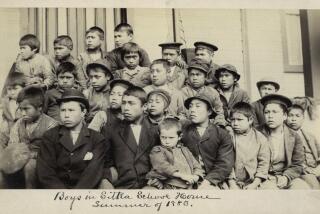Begay, USGA Look to Draw American Indian Youths to Game
ALBUQUERQUE, N.M. — The young American Indian stood on a practice tee on a Saturday morning 20 summers ago, his hands wrapped around a golf club, a bucket of balls at his feet.
In a groove of confidence and concentration, the 7-year-old boy hit one ball after another into the air, unaware of the adult who had walked up behind him.
“I eased up to him ‘cause I didn’t want him to see me,” said Notah Begay Jr., the boy’s father. “He was hitting it really pure. I thought to myself, ‘How come my ball goes every which way and his is going so straight?”’
The youngster hitting balls long and straight was Begay’s oldest son, Notah Begay III, an emerging star on the PGA Tour and a leader in a national effort to bring more Indian youths into the game.
The 27-year-old Begay, who last week played in his first Masters, sees junior golf programs as more than a vehicle for developing future pros.
“I want to give kids an alternative to participation in gangs, to just sitting around and wasting their time with their friends,” said Begay, the only American Indian on the PGA Tour. “If there is something out there for them to do and put their time into, and there’s a goal beyond that, it gives them an opportunity.”
The driving force -- organizational and financial -- for the national project is the U.S. Golf Association. Working with the Native American Sports Council, of which Begay is a member, the USGA is providing thousands of dollars to start up junior golf programs in Indian country. Before last year, no such programs existed.
At the same time, more tribes are going into the golf business as Indian-run casinos prosper. In New Mexico, pueblos like Isleta, Santa Ana and Pojoaque are using some of their casino revenue to build golf courses and expansive hotels.
“It’s extremely positive for the future of the tribe,” said George Rivera, lieutenant governor of Pojoaque.
In 1999, the USGA provided grants to eight programs, five of them in New Mexico. Others were in Wisconsin and North Dakota.
“The prospects for 2000 are very exciting,” said Taa Dixon, who is in charge of the program. “I’m currently working with about 18 different tribes ... from Oregon to Oklahoma, North Dakota and Montana. More in Navajo country.”
The junior golf programs on Indian land are being funded with money the USGA earns from selling broadcasting rights to high-profile events like the U.S. Open. Tribes and pueblos that receive grants provide matching funds, Dixon said.
Golf’s growing popularity among the tribes has a lot to do with Begay. Idolized by Indian youths, Begay won two tournaments on the PGA Tour during his rookie season in 1999, and earned more than $1.2 million.
Begay is half-Navajo and half-Pueblo Indian. His road to the tour began at the Ladera municipal golf course on Albuquerque’s west side, where he worked his way through countless buckets of balls to develop the talent that earned him a scholarship to Stanford.
He earned a degree in economics and was a teammate of Tiger Woods, who has helped expand golf’s popularity more than any other player in the last three years. And like Woods, whose father is black and mother is Thai, Begay has helped take golf further away from its country-club roots.
Each year, Begay puts on golf clinics for youngsters of all nationalities and frequently returns to Albuquerque to work on his game between tour events.
“He’s in tune with the kids. He can talk to them,” said Jill Trujillo, a pro at the Isleta Eagle course and head of the junior program on that reservation. “On TV, you see a lot of Caucasian guys out there. Finally, there’s someone they know and can identify with.”
Begay himself admitted he needed to regain his fans’ trust after he pleaded guilty this year to a drunken-driving charge and spent a week in jail.
“You do something wrong, you pay the price,” he said. “It’s going to take some time to regain the confidence and support of my fans, and I’m going to lose some of them. That’s just the nature of the beast.”
But there’s been no indication that Begay’s favorite fans have turned away.
On a recent outing at Ladera, a group of kids showed up from Canoncito, a desolate, rural Navajo community 35 miles west of Albuquerque. Last fall, Begay accepted a $20,000 check from the USGA to get a junior program started there.
Most of the kids have never held a golf club.
Matthew Mexicano and Virgil Denetso, both 16, shared a 5-iron and some success during their first visit to Ladera, the same driving range where Begay once practiced daily.
“Golf is just a fun game,” Denetso said. “This is a good place to get away from things; to just kick back and have some fun.”
In the eastern Arizona Navajo community of Ganado, Robert Becker leads an 18-member student golf team. The nearest course is 50 miles away in Gallup, N.M., so Becker, a math and chemistry teacher at Ganado High School, makes the 100-mile round trip with his team whenever they can to practice or play. Most of the team’s golf clubs were donated by Gallup pro Alex Alvarez.
Becker said the Ganado team hopes to get a USGA grant.
“They’re very enthusiastic,” Becker said. “They are anxious to learn. They are looking forward to college opportunities and later on, becoming like Notah Begay.”


